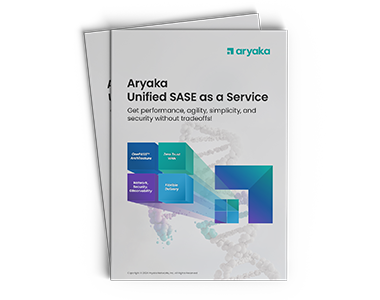Four Questions to Ask Before Deploying SD-WAN

SD-WAN has become the definitive buzzword in enterprise networking, and if you’re a decision maker in IT, chances are the technology has come up in conversation. According to Gartner, by 2018, 40% of WAN edge infrastructure will be based on SD-WAN or something similar.
What is SD-WAN?
In a nutshell, software-Defined Wide Area Network (SD-WAN) simplifies enterprise connectivity between remote locations and branch offices. Common features of a SD-WAN solution include:
- Combining network links of one location into a single pool of capacity available for all applications and services
- Customization of the bandwidth and connectivity to meet the needs of your specific network services, locations, or users
- The ability to centrally define and manage policies and network traffic without requiring manual configuration at each device.
Many startups and tech giants have positioned themselves as an SD-WAN solution, each with their own idea on how the technology works and what solution it offers the business. Yet with so many vendors out there claiming to be SD-WAN, it’s hard to determine which solution is right for your business.
There are three major ways to provide SD-WAN services: deploying SD-WAN only over the Internet, implementing SD-WAN on a mix of MPLS and Internet links, or a global SD-WAN, in which the software is built into a global cloud-native private network.
Below are four questions you need to ask before deploying an SD-WAN to meet your business connectivity needs:
Do you need an SD-WAN with a network or just a routing device at the edge?
Internet-based SD-WANs reduce costs and complexity at branch offices, and also provide better application control. This works well for businesses with multiple offices in a single geographical location, but global enterprises with offices in multiple continents or separated by large distances will have trouble with application performance due to high latency and the variability of connections. Plus, IT must be responsible for building and managing the network around the globe.
A global SD-WAN provides an integrated solution that is focused on application delivery and not on buying separate components. The service embeds SD-WAN functionality into a cloud-native private network, and has redundancy built in. This saves costs compared to the approach of having dual MPLS links or a combination of MPLS and Internet.
Also, since the technology is built over a private network, there is no need to replace or upgrade hardware at the edge. It also can provide an optimized network for faster application performance from anywhere in the world.
Do you need to address connectivity for regional or global deployments?
If all your branch offices are within a local area, and the Internet quality is extremely high, then an Internet-based SD-WAN deployment might be sufficient for your needs. With an Internet-based deployment, a business can reduce network cost and complexity by replacing regional MPLS links with broadband. However, by using the Internet as your WAN backbone, you cannot address global application performance issues. This is because the Internet is plagued with unreliable latencies and congestion-based packet loss and these issues are aggravated over large distances.
For global SD-WAN deployments, you get to leverage a private network to improve data and application performance. The State of SD-WAN Connectivity report dives deeper into the application performance comparison between SD-WANs that use the internet versus a global private network. The report shows, for example, that
- Global private networks provide 4.1x faster application response time compared to the Internet. Improved application performance increases productivity and revenue for global enterprises.
- Global private networks provide 2.5x lower variation in response times compared to the Internet. Stable and reliable connectivity to data and applications improves application performance and end user experience.
SD-WAN architectures built on a private network also provide better security and reliable connectivity with SLAs. WAN traffic traverses through a private network and is not subjected to congestion or inconsistencies common with the Internet.
Do you need to address connectivity requirements for on-premises or cloud/SaaS applications?
If majority of your applications are on-premises and hosted close to end-users, Internet-based SD-WANs can address your connectivity requirements. However, for accessing cloud and SaaS applications over long distances, there are not many viable WAN solutions.
Accessing cloud services and SaaS applications like AWS, Office 365, SAP Business ByDesign, etc. over the congested public Internet can be unreliable and slow, due to heavy packet loss and fluctuating latencies. Internet-based SD-WANs cannot address this issue, as they too rely on the vagaries of the public Internet. Trying to build private networks with MPLS is not possible in all cases, as the legacy technology offers very limited connectivity to only a few public cloud services and almost none of the SaaS applications.
SD-WAN solutions built on a cloud-native private network are a great fit for global, cloud-reliant businesses. These solutions offer MPLS-grade connectivity worldwide for accessing all cloud and SaaS applications, therefore enabling enterprise cloud transformation initiatives.
Do you want to manage your SD-WAN in-house or have it delivered as a service?
In the past, global enterprises would construct their own network infrastructure to provide employees with the right access to data and applications. Orchestration of the network could sometimes be easier at first when building your network with WAN management software and Internet-based SD-WAN devices at the edge. However, as a business needs to scale (especially worldwide), they can find themselves dealing with multiple providers managing tens of ISP or MPLS contracts, plus integration can become a hassle, especially when mergers and acquisitions take place and you have a variety of disparate networks to either combine or manage.
With an As-A-Service model, enterprises can consume their network the same way they as they would consume applications like Salesforce or cloud services such as AWS. All the WAN management is taken care of by the provider. There is no CapEx, and it is faster to deploy than waiting for hardware to implement at each branch office and setting up legacy infrastructure such as MPLS.
Choosing the Right SD-WAN Solution
SD-WAN can make it easier and cheaper for an organization to spin up new branches or set up offices from anywhere, but it is important for any IT leader to assess the needs of their enterprise before doing so. The size of your business, its locations, and the way you want to manage the network is very important to determine before embarking on an SD-WAN deployment.
- Accelerate CAD/CAM Performance
- Improve Zoom Conferencing Performance
- Calypso Embraces a SaaS-first Strategy
- CallisonRTKL Transforms their WAN
- Kleinfelder Improves Application Performance
- Teradyne Transforms their WAN
- SAP web application performance
- Kleinfelder Improves Application Performance
- Industrial Manufacturing Company Transforms WAN









